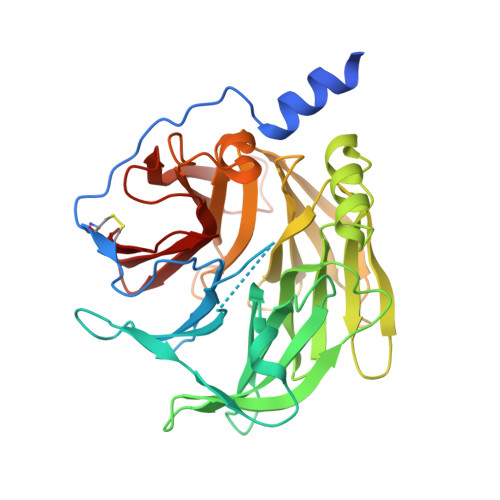Enzyme Evolution: An Epistatic Ratchet versus a Smooth Reversible Transition.
Ben-David, M., Soskine, M., Dubovetskyi, A., Cherukuri, K.P., Dym, O., Sussman, J.L., Liao, Q., Szeler, K., Kamerlin, S.C.L., Tawfik, D.S.(2020) Mol Biol Evol 37: 1133-1147
- PubMed: 31873734
- DOI: https://doi.org/10.1093/molbev/msz298
- Primary Citation of Related Structures:
6G82, 6GMU, 6H0A - PubMed Abstract:
Evolutionary trajectories are deemed largely irreversible. In a newly diverged protein, reversion of mutations that led to the functional switch typically results in loss of both the new and the ancestral functions. Nonetheless, evolutionary transitions where reversions are viable have also been described. The structural and mechanistic causes of reversion compatibility versus incompatibility therefore remain unclear. We examined two laboratory evolution trajectories of mammalian paraoxonase-1, a lactonase with promiscuous organophosphate hydrolase (OPH) activity. Both trajectories began with the same active-site mutant, His115Trp, which lost the native lactonase activity and acquired higher OPH activity. A neo-functionalization trajectory amplified the promiscuous OPH activity, whereas the re-functionalization trajectory restored the native activity, thus generating a new lactonase that lacks His115. The His115 revertants of these trajectories indicated opposite trends. Revertants of the neo-functionalization trajectory lost both the evolved OPH and the original lactonase activity. Revertants of the trajectory that restored the original lactonase function were, however, fully active. Crystal structures and molecular simulations show that in the newly diverged OPH, the reverted His115 and other catalytic residues are displaced, thus causing loss of both the original and the new activity. In contrast, in the re-functionalization trajectory, reversion compatibility of the original lactonase activity derives from mechanistic versatility whereby multiple residues can fulfill the same task. This versatility enables unique sequence-reversible compositions that are inaccessible when the active site was repurposed toward a new function.
Organizational Affiliation:
Department of Biomolecular Sciences, Weizmann Institute of Science, Rehovot, Israel.















